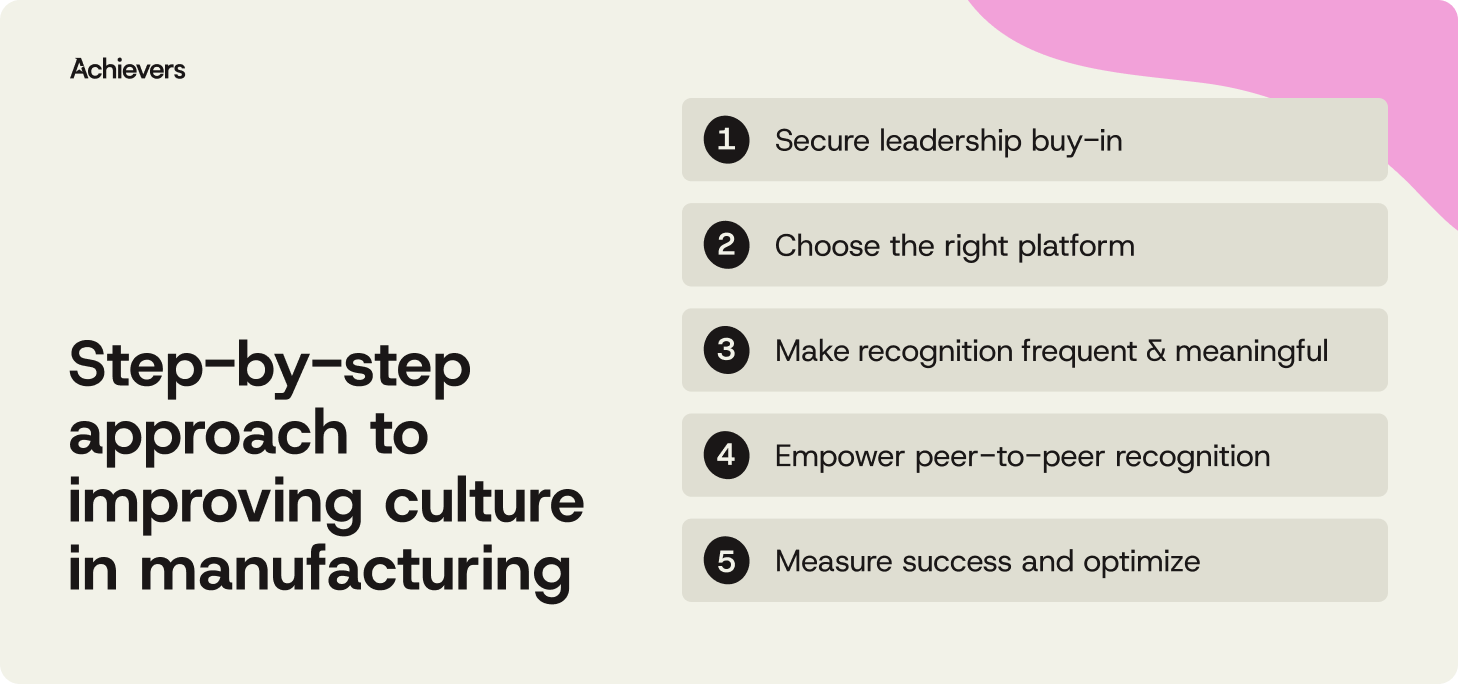Table of contents
Create a culture that means business™
Schedule a demo with an Achievers solution expert today.
Manufacturing can be a tough industry. It takes hard work to meet tight deadlines and rigorous standards. While there’s a lot of pride that comes with toughing it out in a demanding industry, in the wrong environment, your HR team can wind up awfully busy.
High turnover is a huge problem for manufacturers. In fact, nearly 60% of manufacturers say they struggle to find and retain talent. Let that sink in.
Company culture is one of the most widely cited reasons for high departure rates, rising recruitment and training costs, and reduced productivity, but it doesn’t have to be that way. The secret to building a better culture is simple: employee recognition. It’s not your grandfather’s factory anymore. Making sure employees feel recognized and valued can completely transform your workplace culture, and your bottom line along with it.
The unique culture challenges in manufacturing
The manufacturing sector faces unique challenges when it comes to culture and employee motivation. It’s a sector that struggles with high turnover rates, persistent labor shortages, communication barriers between employees and leaders, and workforces that are primarily on the frontline.
In too many manufacturing companies, there’s a divide between white-collar and blue-collar roles. Ideas like “culture change” are a hard sell on the production floor. For culture change to be meaningful, you need to break down walls and bring change to the frontline.
These realities create a perfect storm of obstacles that make it difficult to build a cohesive, engaged culture — especially at scale. Here are some of the most common culture-related challenges manufacturing companies face:
High turnover rates
High turnover is a constant issue in manufacturing, and it’s not going anywhere on its own. The sector as a whole faced a turnover rate of 11.8% last year. The costs of lost productivity and rehiring are nothing to sneeze at. They can be as much as $100,000 or more annually.
What’s driving turnover? An older, retiring workforce is one factor, but 24% of manufacturers cite a competitive job market and better company cultures elsewhere. But the grass doesn’t have to look greener on the other side.
Labor shortages
Nearly one-third of manufacturing companies report open positions that they just can’t fill, and there are concerns that the labor gap is only going to widen. According to Deloitte, the U.S. manufacturing sector could see as many as 1.9 million unfilled manufacturing positions by 2033.
Younger generations are less inclined to pursue careers in manufacturing. A lack of applicants with relevant experience and hard skills are the leading reasons reported by manufacturers for positions going unfilled.
How can employers make themselves more attractive? Start by asking yourself what you’d look for in a great employer.
Communication barriers
Many manufacturing employees work in roles that lack direct access to email or company intranet. They’re on the floor, not checking their emails every five minutes. They’ve got a job to do, and they can also be skeptical of the value of the work done in corporate. And let’s be honest – sometimes they may have a point.
These communication barriers can stand in the way of employee recognition, engagement, and building a better culture. Balancing communications between online and offline employees will always be a challenge.
Without clear, ongoing communication with leadership, employees can feel disconnected from company goals. Leadership needs to be in frequent communication with all of their employees, not just the desk jockeys.
Frontline-heavy environments
The manufacturing workforce is largely made up of frontline employees who don’t have access to the traditional office perks. They’re busy making things happen, not scheduling meetings and “circling back.” Frontline employees can often feel unseen and undervalued compared to corporate roles, creating a divide between the office and production workers.
A successful employee recognition program has to be designed to reach and engage employees on the shop floor. It needs to feel authentic, not forced. That’s when people start to feel like they’re part of something bigger than just another job.
Why recognition is the key to cultural transformation
Putting in long, hard days without recognition from peers or team leaders can quickly make employees feel underappreciated. A small thank you makes a big difference. And when you add incentives and rewards to those recognitions, the response you get can change from an eye roll into heartfelt appreciation.
The gap between frontline and non-frontline worker engagement is real. Research conducted by PwC found that less than half of frontline workers reported feeling engaged, compared to 70% of non-frontline workers.
What causes disengagement? While compensation and benefits lead the pack, frontline workers also list purpose (86%), recognition (78%), and personal growth (68%) as important factors for creating meaningful work.
Company culture shapes the way employees approach their jobs. Most manufacturers recognize that frontline leaders are the most important point of contact in the employee experience. Frontline leaders see who steps up, who meets tough quotas, and who’s there to help their colleagues. They’re in the best position to recognize a job well done.
Steps to implement a recognition-driven culture shift
Driving a culture shift in manufacturing can seem like an uphill climb, but Achievers is your chair lift to the top. The right recognition and rewards platform supports your journey with best practices, thought leadership, and workplace science. Leadership buy-in and platform adoption are crucial components of successfully changing workplace culture. Everyone from the C-suite to team leaders should see the benefits of a recognition-driven culture shift.

1. Secure leadership buy-in
Start by educating executives and managers on the ROI of recognition. When leadership models recognition behaviors, it sets the tone for company-wide adoption. Recognition platforms are proven to reduce turnover and increase employee engagement in manufacturing. These are benefits with a tangible impact on the bottom line. Get leaders onboard first and early.
2. Choose the right platform
Success starts with the right platform. For manufacturers, that means an R&R platform designed for frontline and shift-based employees. Achievers Recognize ensures mobile accessibility and real-time recognition to engage all workers, not just the ones working corporate. Employee incentive programs for manufacturing need to reach the people on the production floor.
3. Make recognition frequent and meaningful
Have you ever had to wait for an annual review before getting any kind of recognition? Imagine spending an entire year with no meaningful feedback, and all the smaller moments, triumphs, and wins that would get lost in the shuffle.
Recognition works best when it’s both frequent and meaningful. Encourage leadership to practice daily or weekly recognitions. Tying those recognitions to company values and business goals aligns employee behaviors with your greater vision.
Strategic recognition increases employee retention and loyalty when implemented successfully. Research from Gallup finds that workplaces with a strong sense of belonging created through frequent recognition can lead to a 43% increase in retention.
4. Empower peer-to-peer recognition
Whose “thank you” means more than the boss’s? Usually, it’s the people you work with day in and day out. Peer-to-peer recognition is your secret weapon for a successful recognition program. Allowing employees at all levels to recognize one another on your platform fosters teamwork and builds morale.
Empowered peer-to-peer recognition is more than a thank you — it can also be turned into real rewards. Create a points-based system where employees accumulate points from leadership and peer-to-peer recognition in exchange for tangible rewards on the Achievers global rewards marketplace. Turn saying “great job” into real rewards that your employees will get excited about.
5. Measure success and optimize
Finally, make sure you’re measuring success and activity on your recognition platform to optimize results. You can track recognition activity and engagement metrics using platform analytics, including activation rates and frequency of recognitions. Gather employee feedback through surveys, quizzes, and other feedback tools to adjust the program and continuously improve performance.
Achievers: A recognition solution built for manufacturing
Achievers helps leaders build cultures where employees feel seen, heard, and valued — especially on the frontlines.
Achievers Recognize delivers twice the frequency of recognition compared to other platforms and drives up to 5x higher engagement and productivity. It’s designed for real-world manufacturing environments, with:
- Mobile access for frontline teams
- Peer-to-peer and manager recognition
- Integrations with Outlook, Teams, Slack, and more
- Real-time insights to track what’s working
Need help putting recognition into practice — without slowing down the floor? The manufacturing recognition playbook is built for exactly that. It’s full of simple, actionable tools to help you build habits that stick and make recognition part of how your team works every day.
Here’s what you’ll find inside:
- Checklists to build daily recognition habits across shifts and sites
- Real examples from manufacturers improving engagement and retention
- Tips for tying recognition to goals like safety, productivity, and morale
Because when it’s frequent and meaningful, recognition works and pays off. Companies using recognition platforms see up to 30% lower turnover. In manufacturing, that’s more than a win — it’s a competitive edge.
Real-world success: How manufacturing leaders use recognition to drive culture
Global manufacturers like General Motors (GM) use Achievers to align employees with their vision and drive culture change at scale. With over 160,000 employees across six continents, GM needed a consistent, global solution to rally teams around its bold goal of “zero crashes, zero emissions, and zero congestion.”
By adopting Achievers, GM launched a unified recognition platform that reached 67,000+ employees at rollout. The platform delivered real-time data, boosted engagement, and simplified recognition across locations. In the first year alone, it saw a 97% activation rate, with 80% of managers and 60% of employees using it monthly.
Building a culture that retains and motivates
Recognition has an enormous role to play in shaping manufacturing culture. Recognition and rewards foster a greater sense of belonging, employee well-being, and loyalty, reducing turnover rates and improving engagement and productivity. Frontline manufacturing employees report high rates of disengagement and dissatisfaction, often because they feel overlooked compared to their corporate counterparts.
You have a chance to turn that paradigm on its head. Manufacturing leaders can use Achievers to create a culture where employees experience frequent recognition and get rewards that they’ll actually want. Turn your organization into an industry leader that attracts the best people available.



